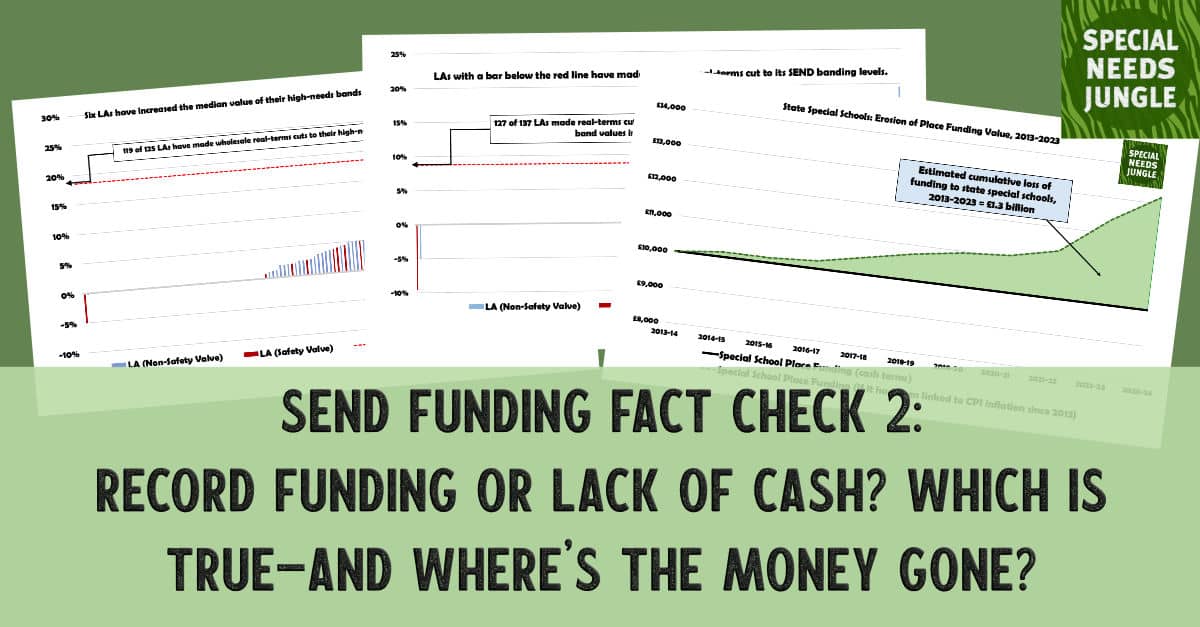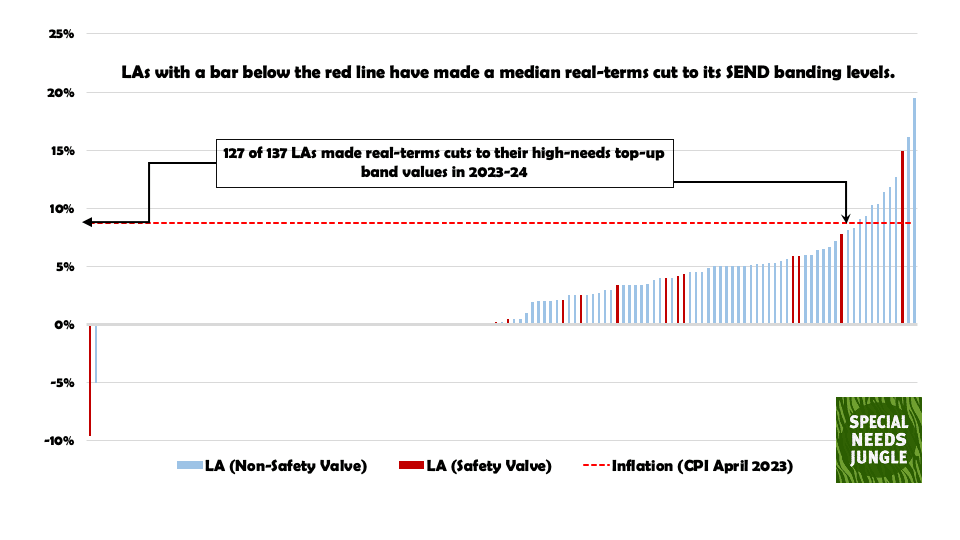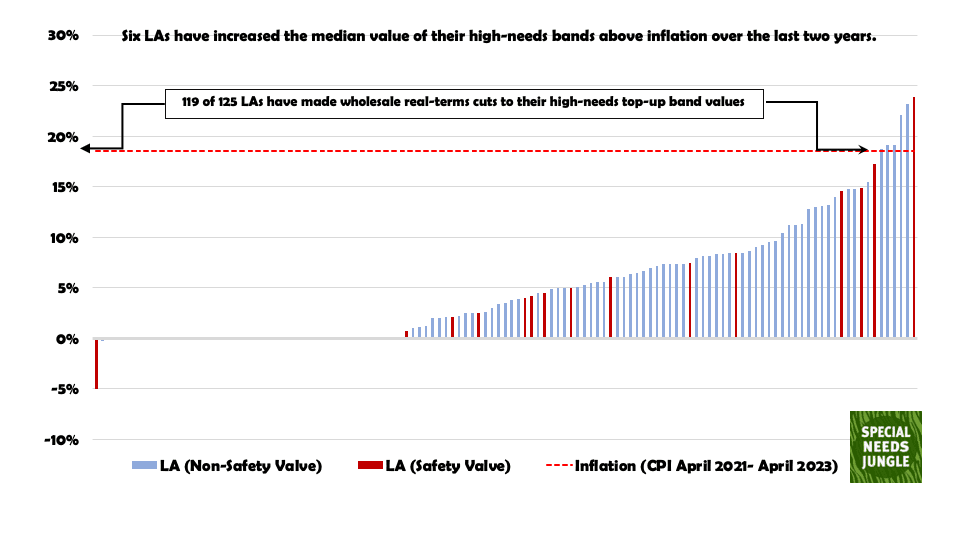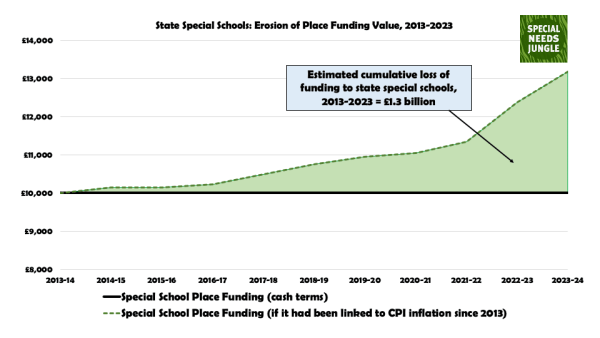
This is the second in a series of ‘what’s happening?’ posts on SEND funding. In the first post, we looked at the Department for Education’s claim it’s made record increases to SEND funding. But despite this, school leaders and local government leaders say that they’ve never been in a worse financial position to support children and young people with SEND.
Those things can’t both be true, can they? Yes, they can, and they probably are.
A quick recap from the last post: insanely, nobody really knows how much money is spent on SEND each year. But we know about some of it. The main funding pot for complex SEND is called the High Needs Block (HNB). The Department for Education says that by April 2024, it’ll have increased the size of the HNB for SEND by 60% over five years.
We looked at that claim in the last post. It’s generally accurate…but it’s not the whole story.
Where’s the beef?
So what are schools and LAs complaining about? With all this extra high-needs funding cascading downwards from on high, you might think that things at ground level look like the Scarface montage scene with stacks of cash covering every surface.

Does it look like that? Not in the slightest. Most of the High Needs Block is doled out to schools and colleges by local authorities and despite central government giving LAs much more high-needs funding, very little of the extra money is making a positive difference at the level of individual pupils. Worse still – in real terms, despite the hefty increase to the High Needs Block, schools and colleges are mostly getting less high-needs funding per pupil than they did a few years ago.
How is that possible? To explain that, we’ve got to go back to banding.
Back to the Banding
Almost every English LA uses some form of pupil-level ‘banding’ system to allocate high-needs funding to schools and colleges so they can deliver provision for pupils with Education, Health and Care Plans (EHCPs). This is usually called ‘top-up’ funding, and it sits on top of a basic place-level funding wodge that each state school gets.
Most LAs have a banding system that, for each pupil with an EHCP, loosely links funding levels to a described level of need. For example, a mainstream school educating a severely deaf pupil might get £1,000 each year in high-needs ‘top-up’ from the LA to fund that child’s extra SEND provision. If they’re educating a profoundly deaf child, they might get £7,000 per year, and so on.
There’s no national system here, each LA basically rolls its own – a crazed patchwork of local funding arrangements that these days, usually have more to do with keeping costs controlled than they do with the actual cost of provision. Every year, we ask LAs what high-needs ‘top-up’ banding system they use, and whether they’ve changed the funding values for each band. This year, we collected enough data to run analysis for 137 of England’s 153 local authorities.
The results are grim. Not quite as bad as school-pay-rise-las-dont-pass-funding-send-pupils-suffer/”>last year’s, but still grim.
Illustrating the funding
Check the graph below, but in words:
- In 2023-24, most LAs made a small median increase to their high-needs ‘top-up’ band values this year – but with inflation factored in, this ‘increase’ was almost always a real-terms cut.
- Almost half the LAs we asked had not increased their band values at all. Depending on how you calculate inflation, that’s a real-terms cut of 6.5% to 9%, in a single year.
- Compared with last year, only 10 of the 137 LAs had made median increases to their ‘top-up’ band values that matched or outpaced inflation.
If you look at the graph, every LA with a bar below the red line will have made a median real-terms cut to its banding levels.

Inflation has been high for a while now, so things look even worse if you run the numbers back further to 2021. We identified only six LAs that had increased the median value of their high-needs bands above inflation over the last two years.

A few LAs have kept their mainstream band values static for a decade. Thanks to wage inflation and deliberate LA decision-making, the per-pupil top-up funding that these schools get from the LA probably buys 30% less support than it did a decade ago.
We also ran the numbers for 31 of the 34 LAs that are currently in the DfE’s Safety Valve financial intervention scheme. The other three LAs chose not to share the data with us. For those that did, all but one inflicted real-terms cuts on their high-needs top-up band values.
What does this mean for LA education settings?
What this means, for state schools and colleges, is simple. At a per-pupil level, in real terms, most schools are getting less high-needs funding to support their SEND pupils than they did last year: often a lot less. This means that badly-needed pay rises for many school staff are usually coming in largely unfunded, at a time when schools and colleges are struggling to recruit and retain.
And if you’re running a state special school, then you’re getting doubly shafted. Back in 2013, central government set the base funding value of a state special school place at £10,000. Today, at the beginning of 2024, it’s still £10,000 – with inflation, that funding figure buys around 30% less support now than it did ten years ago.
We estimate that over the last 10 years, this policy decision has probably deprived state special schools of around £1.3 billion in funding – including £360 million in the last year alone.

Things aren’t great for the special school sector – but the batshit is splattered all over mainstream too.
The Book of Hours
At least one in every five LAs still doles out high-needs ‘top-up’ funding to mainstream schools using calculations based on hours of support. Under this model, if a pupil with an EHCP needs, let’s say, 20 hours of support in a week, then the school is expected to fund many or most of these hours of support from its own budget, with the LA providing a financial top-up for the rest of the hours from its High Needs Block allocation.
In reality, there might not be any hours quantified in the EHCP itself, or any specification of the staff providing the support – so we’re already at least halfway through the looking-glass before running the numbers.
Assuming normal on-costs, under 2023-24 pay scales, hourly support might cost the school around £14.50 per hour for a teaching assistant, or around £17 per hour for a high-level TA. We looked at the data from LAs that still use top-up systems based on hours. Most are providing schools with top-up funding at less than £14.50 per hour, and some are providing a lot less.
The lowest LA mainstream hourly top-up rate we’ve seen is £9.33 per hour (although this rate is being phased out); we’ve seen others equating to around £10 per hour. At the other end of the spectrum, some LAs are paying schools £17-18 per hour in top-up.
There’s no rhyme or reason here: some of the stingiest LAs are in the Home Counties, some of the most generous LAs are in deprived areas. Some of these systems – particularly the combinations of hourly rates and thresholds for top-up funding – look wide open to legal investigation.
At the very least, an LA that is doling out top-up funding to schools at an hourly rate that’s lower than what it costs to employ someone on minimum wage is simply – and knowingly – pushing legal and financial risk down onto schools. And the law is clear on who holds the statutory duty to secure educational provision for children and young people with EHCPs – the LA.
What is the DfE doing about this?
The DfE’s SEND & AP Improvement Plan proposes to set up a national system of high-needs funding bands and tariffs, linked to a set of national standards. The stated aim is to bring harmony to the SEND financial system. They might not succeed. It’s not certain they’ll even try. Nothing is likely to change this side of 2025, despite MPs on the Levelling Up Committee this week succumbing to LA demands to (again) review the entire EHCP system, blaming parents for their “lack of confidence” in mainstream. And the DfE has nothing to say about the place funding issue that is shafting state special schools to the tune of hundreds of millions of pounds per year.
But what exists right now is a deranged crapshoot, where funding allocations bear little relation to meeting either children’s needs or statutory duties, and that vary hugely from LA to LA.
So this is where we are. We’ve got a big rise in high-needs SEND funding from central government. But at a per-pupil level, schools and colleges are usually getting less real-terms funding, because of the ways that LAs dole out high-needs SEND cash.
Why is this happening? Are we looking at a simple case of unmitigated LA dirty deeds? No, not entirely. The final part of this series will look at why.
Sign up below for new post alerts so you don’t miss it…
Also read:
Don’t miss a thing!
Don’t miss any posts from SNJ – simply add your email address below. You must click the link in the confirmation email you’ll receive to activate your free subscription.
You can also keep up with us by following our WhatsApp Channel!
Want more? Be an SNJ Patron!
SNJ is a non-profit company and everyone who writes here does so voluntarily. We need your support to help us with costs by donating once or as a regular patron. Regular donors get an exclusive SEND update newsletter as thanks! Find out more here
Related
#SEND #Funding #Fact #Check #Record #funding #lack #cash #trueand #wheres #money #Special #Jungle





More Stories
Lamination Experiment – Mrs. D’s Corner
Must-Have Containers for Special Education Teachers – Simply Special Education
“What Happens When You Give a Tape Recorder to a Chatty Kid”